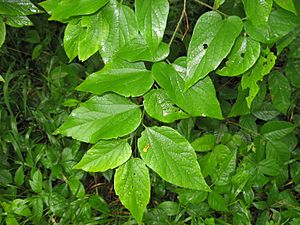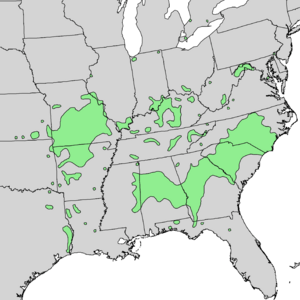Dwarf hackberry facts for kids
Quick facts for kids Dwarf hackberry |
|
|---|---|
 |
|
| C. tenuifolia leaves after a rain | |
| Conservation status | |
| Scientific classification | |
| Genus: |
Celtis
|
| Species: |
tenuifolia
|
 |
|
| Generalized natural range of Celtis tenuifolia | |
The dwarf hackberry, also known as Georgia hackberry (its scientific name is Celtis tenuifolia), is a type of shrub or small tree. It usually grows to be about 2 to 12 meters (about 6 to 39 feet) tall.
This plant naturally grows in eastern North America. However, it's quite rare north of the Ohio River. In Canada, the dwarf hackberry is considered a "threatened" species. This means it's at risk of disappearing, so it's protected by a law called the Species at Risk Act.
Contents
What Does Dwarf Hackberry Look Like?
Leaves and Buds
The leaves of the dwarf hackberry grow one after another along the stem. They are simple, meaning each leaf has a single blade. These blades are usually 5 to 7 centimeters (about 2 to 2.8 inches) long and 2 to 3.5 centimeters (about 0.8 to 1.4 inches) wide. They have small teeth along their edges and feel a bit hairy.
In winter, the plant's buds are brown and hairy. They look like buds on other hackberry trees but are much smaller, only 1 to 2 millimeters long. This tree does not have a bud at the very tip of its branches.
Flowers and Reproduction
Dwarf hackberry plants have both male and female flowers on the same plant. These flowers are separate, meaning some are only male and some are only female. They grow either alone or in small groups.
The wind helps these plants reproduce by carrying pollen from one flower to another. The plant can also pollinate itself, which means it can make seeds even if there isn't another dwarf hackberry nearby.
Fruit
The fruit of the dwarf hackberry looks like a small berry. It's called a drupe, which means it has a soft, fleshy outside and a hard pit or "stone" inside. Each fruit is about 5 to 8 millimeters (about 0.2 to 0.3 inches) wide and contains one stone.
When the fruit is young, it's green. As it ripens, it changes color from light orange to dark red, and then to a purplish-brown. The outer part of the fruit is smooth, and the inside is soft and yellow. This part of the fruit is sweet and can be eaten.
Where Does Dwarf Hackberry Grow?
Habitat and Growing Conditions
The dwarf hackberry doesn't like a lot of shade. It can handle dry conditions very well and grows slowly. You'll often find it in dry, high areas like open woodlands, or in special grassy areas called alvars. It also grows in sandy spots near shorelines.
This tree usually doesn't grow right next to other types of hackberry trees. However, if other hackberry species are nearby, you might sometimes see plants that are a mix of both types. Like other hackberry trees, the dwarf hackberry likes soil that has a good amount of lime (a type of calcium). It's often found growing in thin soil over limestone rock.
Wildlife and Dispersal
Many songbirds and other animals enjoy eating the fruit of the dwarf hackberry. When they eat the fruit, they help spread the seeds to new places, which helps the plant grow in different areas.
See also
 In Spanish: Celtis tenuifolia para niños
In Spanish: Celtis tenuifolia para niños


